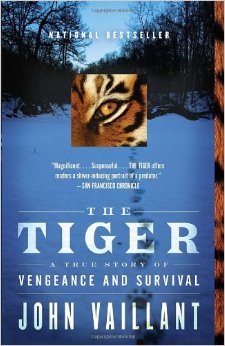
Winner of the 2010 B.C. National Book Award for Non-Fiction
Winner of the 2010 Hubert Evans Non-Fiction Award
Winner of the 2010 CBA Libris Award for Non-Fiction
A Globe & Mail Best Book ~ 2010
A Quill & Quire Best Book ~ 2010
Selected for Canada Reads 2012
The 2012 edition of Canada Reads switched gears a bit and focused on non-fiction titles for the first time. I remember thinking then that The Tiger by John Vaillant stuck out a bit from the others. It was the only book that didn’t have a Canadian connection, other than the author’s nationality, and it was the only history narrative, while the other four were all memoirs. As such, this title got a rough ride on the show. But, more than most of the other titles that year, this one caught my interest. I planned on reading the book while listening to shows, and it only took me over 3 years to actually get to it. Who wouldn’t be interested in a classic man-versus-nature story of a man-eating tiger? There is a certain primitiveness to this idea. A challenge to Man’s rank in the natural pecking order. What Vaillant has delivered in The Tiger, is an interesting mix of history, nature writing, political science, and psychology.
I’m going to give The Tiger a solid “ok.” Certain aspects of the book were very interesting. Vaillant’s digressions into the biology, ecology, evolution and biogeography of tigers were the highlight of the book; additionally, he went into great depth in exploring the current conservation status and the sharp decline in tiger numbers. During these chapters, I felt strong overtones of one of my favorite nature titles, Song of the Dodo. Another strong point of this book was the correlations Vaillant drew between perestroika – the opening of the Soviet economy in the late 80s – and the desperate poverty in this remote region of Russia forcing people to resort to things like poaching. It was through this particular lens that the central players in the story were most interesting and developed.
This book was a bit of a slog though. The actual forward motion of the narrative component was a little slow and at some points came to grinding halt. The Tiger could have easily shed 50 to 75 pages. But, oddly enough, during the third and final section, “Trush”, the narrative took off with the pace that I was hoping for and, ultimately, you as the reader do feel satisfied with the conclusion.
With all of that being said, one thing that definitely stands out is the amount of primary research that the author must have done to complete this book. Other than one documentary film and the contemporaneous news stories, there would be very little available in terms of first-hand accounts of these incidents. For the author, I imagine striking out into the backwoods of isolated eastern Russia must have been like entering a different planet.
That’s all I’ve got. This is a rather short review, but I just don’t have much to say. I find I always have lots to say on books that I either really liked or really didn’t like, but books like The Tiger where I am just kinda “meh, it’s alright,” just don’t elicit enough excitement in me either way to write a lengthy response.
